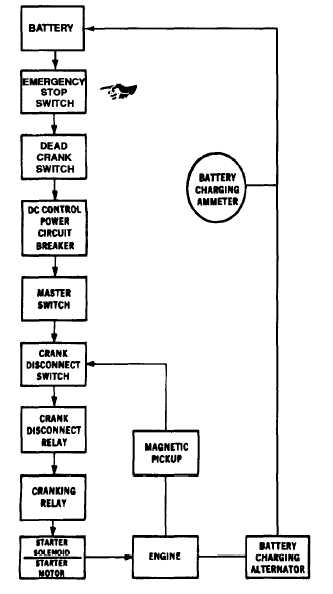ARMY TM 9-6115-642-10
AIR FORCE TO 35C2-3-455-11
MARINE CORPS TM 09247A/09248A-10/1
Section III. TECHNICAL PRINCIPLES OF OPERATION
1-10
This section contains functional descriptions of the
generator set and explains how the controls and indicators
interact with the system.
1-11.
The Engine Starting System (FIGURE 1-3), consists
of two 12-volt batteries connected in series, a starter, a 24 volt
battery charging alternator, a magnetic pickup (for sensing
engine speed) and the related switches and relays required for
control of the starting system. For engine cranking, battery
power is supplied to the starter motor through the starter
solenoid which in turn is controlled by the cranking relay. The
starter then engages the engine flywheel causing the engine to
turn over. For engine starting, the DEAD CRANK switch must
be in the NORMAL position, the DC Control power circuit
breaker must be pushed in, the EMERGENCY STOP SWITCH
must be in the OUT position, and the MASTER SWITCH is
moved to the START position. The cranking relay is then
controlled by a circuit consisting of the crank disconnect relay
and crank disconnect switch. As the engine accelerates to the
preset speed (sensed by the magnetic pickup), the crank
disconnect switch opens and de-energizes the cranking relay to
stop and disengage the starter. The starting sequence may also
be stopped by moving the MASTER SWITCH to OFF. The
engine may be cranked without starting by use of the DEAD
CRANK switch. With the DEAD CRANK switch in the
CRANK position, the cranking day, starter solenoid and
starter motor are energized without activating any other
starting or control function.
FIGURE 1-3. Engine Starting System
Change 1 1-11

